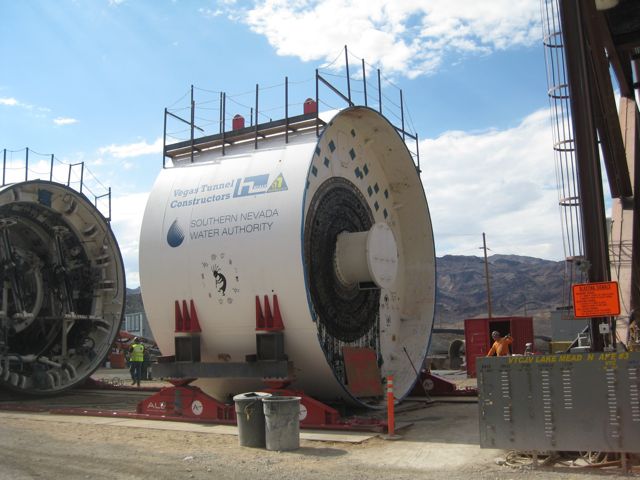Is the age of big concrete – the dams to store western water and the canals and pipes to move it – really over? Are the projects now underway – perhaps the Southern Nevada Water Authority’s “third straw” into Lake Mead – the last we’ll ever see built? (I’m working on a piece that in part will explore this issue. See my questions at the bottom.)

tunnel boring machine, Southern Nevada Water Authority, photo by John Fleck
Three things I’ve read recently have me thinking about this, and I’m looking for some feedback from the smart water wonks in the audience.
The first is a most intriguing essay by Patrick Wilson (pdf here) about the way the existence of big concrete has shaped our western water institutions.
The second is Jay Lund’s analysis of the Bureau of Reclamation’s study of the economics of the $1.1 billion raising of Shasta Dam in California:
This expansion produces an additional 76,000 acre-ft of firm yield (dry year deliveries). This is less than 0.2% of agricultural and urban water use in California. (Modern water engineers will wonder why the antiquated firm yield is still the main water supply indicator.) Average annual deliveries increase by only 63,000 acre-ft. Other traditional benefits (hydropower, recreation, flood reduction) were small.
That’s some mighty expensive water.
The third is Jeffrey Michael’s observations on the latest round of Bay-Delta Conservation Plan analyses:
Given that the incremental water supply being discussed by the conveyance is 0.3 maf to 1.5 maf requested by the water contractors. That comes out to between $3600 and $730 per acre foot of new supply – not counting operations costs – just to get the new water to the Tracy pumps. Add a few hundred dollars more for operating costs and pumping to Los Angeles.
That’s some mighty expensive water.
Big concrete has always meant expensive water, most often subsidized by general taxpayers (mostly federal, but sometimes state as well), but it’s increasingly looking to me like the next marginal increments of water are getting so expensive that these things are going to collapse under the weight of their astronomical costs. I’d be a sucker to bet that the Peripheral Thingie will never be built (I made a bet like that once – never’s tough to collect on), but that’s what I think.
Here’s my quick list of other suggested/proposed/contemplated projects in the western United States subject to this argument:
- Aaron Million’s Flaming Gorge pipeline proposal
- Ute Lake pipeline in New Mexico
- BDCP
- Lake Powell Pipeline in Utah
Question 1 is what else should be on this list? And am I right that these projects are just too expensive to build? Which of the current round of big concrete proposals has the best chance of really being built?
Question 2: If we really are at the end of concrete, what should I call the last project? My vote goes for Vegas’ third straw. But Animas-La Plata has some standing here too. What else is underway now that should be on a list of the West’s last big water projects?

A couple more things to add to the “concrete” list would be Navajo-Gallup project and a number of other rural municipal / industrial water supply projects underway in the Dakotas a la Mini- Wiconi. There will also likely be something coming out of the Aamodt settlement. Notable that most of these are M&I and rural distribution systems so maybe they’re not so much concrete as PVC and steel. There’s going to be continuing development of water infrastructure in the west, but very few if any big dams or irrigation projects.
Do some research into non-compete government contracts and infrastructure and proposed infrastructure (BDCP), whom those non-compete contractors are, follow the trail…yep, this one will lead you right back to Sen. Feinstein and her hubby…Mr. Senator Feinstein, Richard C. Blum.
Concrete is here to stay…as long as we have our public projects rigged this way.
I highly recommend Richard Trainor’s Paradise Lost? Mr. Trainor’s excellent investigative reporting provides the background and blueprints of these infrastructure/stock market-related ‘pump and dump’ schemes.
If you want to understand the politics behind high speed rail, Bay Bridge retrofit, the first Peripheral Canal and how all of this has laid the ground work for what we are being scammed and subjected to today…in the guise of BDCP-type swindles.
Well, since you’re talking about California, you might throw Sites Reservoir on your list.
Chris – Thanks. I’m wondering how to categorize these “small water” projects in my menagerie, and whether my arguments apply to them in the same way they apply to big water like Flaming Gorge or BDCP. And you’re right about materials. My “concrete” metaphor breaks down in a hurry.
Karen – Thanks, I’ll keep an eye on the money trail.
Bruce – Thanks, and how do you think my argument applies (or doesn’t apply) to Sites? Do you think it has a serious chance of being built?
There are environmental and seismic reasons for BDCP. Water can be worth a lot when you can’t get it.
Pingback: Isenberg: you want more storage? who’s gonna pay? : jfleck at inkstain